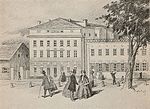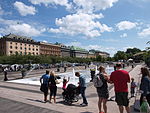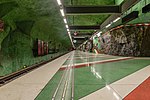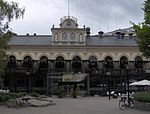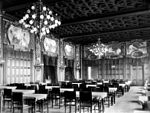St. Eugenia's Church (Stockholm)

Saint Eugenia's Church is a Roman Catholic church in the center of Stockholm (Sweden). It was built in 1982 on plans of the Danish architect Jørgen Kjaergaard and is situated next to the former Royal Gardens, Kungsträdgården in Norrmalm. The Church is consecrated to Saint Eugenia (Eugénie d’Alsace), an abbess (700-735) of the monastery Mont Sainte-Odile in Alsace (France). St. Eugenia's Parish was established in 1837 and is the oldest Catholic parish in Sweden since the reformation; as of 2010 it has approximately 9,000 members. Services are held in Swedish, English, Polish and Arabic. The operation of the church and pastoral care of the parish is overseen by Jesuits.
Excerpt from the Wikipedia article St. Eugenia's Church (Stockholm) (License: CC BY-SA 3.0, Authors, Images).St. Eugenia's Church (Stockholm)
Kungsträdgårdsgatan, Stockholm Norrmalm (Norrmalms stadsdelsområde)
Geographical coordinates (GPS) Address Nearby Places Show on map
Geographical coordinates (GPS)
| Latitude | Longitude |
|---|---|
| N 59.3317 ° | E 18.0724 ° |
Address
Kungsträdgårdsgatan 12
111 47 Stockholm, Norrmalm (Norrmalms stadsdelsområde)
Sweden
Open on Google Maps
